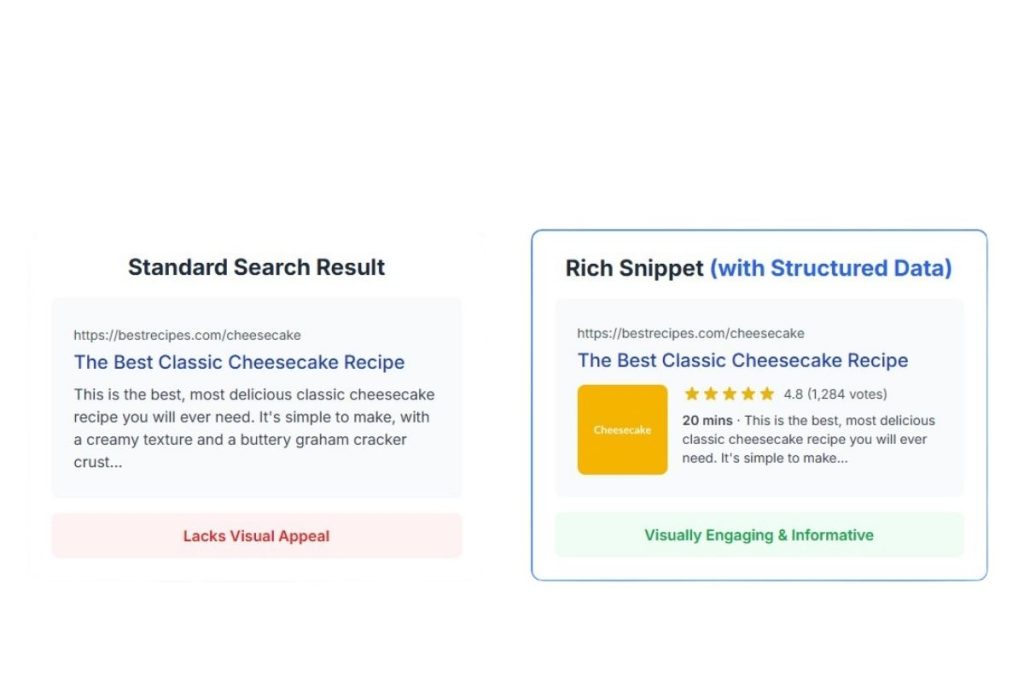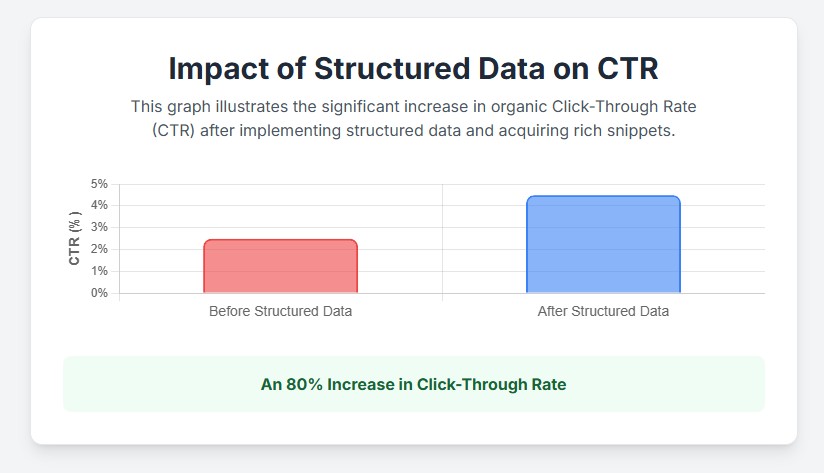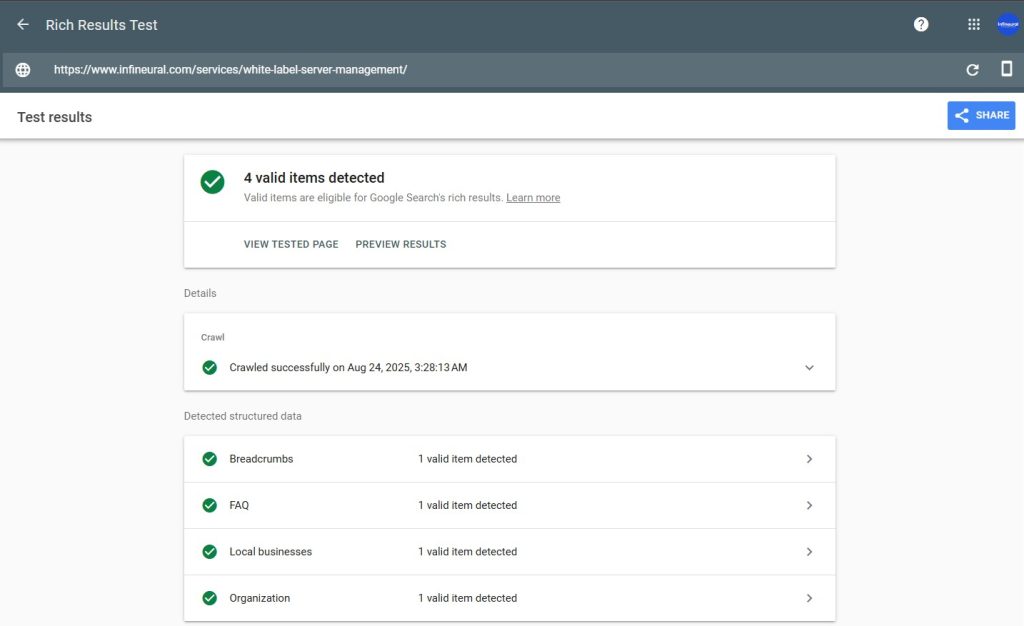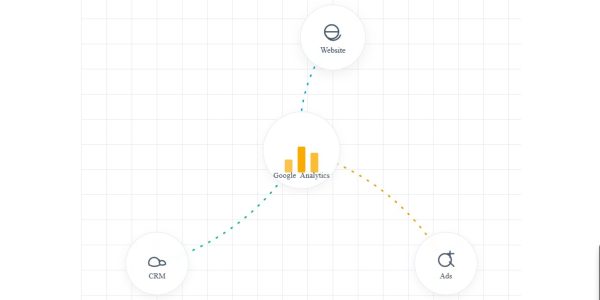Ever wonder why some Google search results are so… extra?
You’ve seen them. The search result with star ratings shining brightly underneath. The recipe with a mouth-watering image and cooking time right on the results page. The FAQ dropdowns that answer your questions before you even click.
These aren’t random acts of Google magic. They are rich snippets, and the secret sauce behind them is structured data.
While your competitors are still fighting for a plain blue link, you could be commanding attention, building trust, and driving more qualified clicks—all by speaking Google’s native language. The problem is, for many businesses, the concept of structured data feels like a complex, technical puzzle.
This guide will demystify it all. We’ll break down exactly what structured data in SEO is, why it’s a non-negotiable part of a modern strategy, and how you can start implementing it today to leave your competition in the dust.

What is Structured Data, Really? (And Why Should You Care?)
At its core, structured data is a standardized format for providing information about a page and classifying its content. Think of it as a translator. Your website’s content is written for humans, but search engine crawlers are just code. Structured data translates your human-friendly content into a machine-readable format that search engines like Google can instantly understand.
When Google understands the context of your content—that this series of numbers is a product rating, this block of text is a recipe instruction, or this address belongs to your local business—it can reward you by featuring that information directly in the Search Engine Results Pages (SERPs).
This process of organizing and translating your data is often referred to as schema markup.
Demystifying the Lingo: Schema, Microdata, & JSON-LD
You’ll hear a few terms thrown around, but they all work toward the same goal.
- Schema.org: This is the vocabulary. It’s a collaborative project by Google, Bing, and Yahoo! that provides a universal set of agreed-upon definitions for all the different types of content you might have on your site (e.g.,
Recipe,Product,Event). - Microdata & RDFa: These are syntax formats for adding schema vocabulary directly into your HTML code. They work, but they can be cumbersome as they are mixed in with your existing HTML.
- JSON-LD (JavaScript Object Notation for Linked Data): This is Google’s recommended format and the modern standard. It’s a script you can place in the
<head>or<body>of your HTML. The biggest advantage? It’s cleaner and separate from your main HTML content, making it much easier to manage and less likely to break your site’s code.
The takeaway: When we talk about implementing structured data in SEO, we are typically talking about using the Schema.org vocabulary in the JSON-LD format.
The Tangible Impact of Structured Data in SEO
Okay, so it helps Google understand your page. But what does that mean for your bottom line? The benefits are direct, measurable, and powerful.
Earning Those Coveted Rich Snippets
This is the most visible benefit. Rich snippets (or Rich Results) are enhanced search results that show more information than the standard title, URL, and description.
Examples include:
- Star ratings for products or reviews.
- FAQ dropdowns under a result.
- Images and cooking times for recipes.
- Pricing and availability for products.
These visually appealing results make your listing stand out, pushing competitors down the page and immediately drawing the user’s eye.
Boosting Click-Through Rates (CTR)
Which result are you more likely to click? A plain blue link, or one with five glowing stars and a clear price?
By providing more information directly in the SERPs, structured data helps users pre-qualify your page. They know what to expect, which means the clicks you get are from more informed, higher-intent users. Studies have shown that rich snippets can improve CTR by as much as 30%. This increased CTR is a strong signal to Google that your page is a relevant and valuable result, which can positively influence your rankings over time.

Enhancing Brand Authority and Trust (E-E-A-T)
When Google features your content in a rich snippet, it’s an implicit endorsement. It signals to users that your site is a credible source of information. This is directly tied to Google’s E-E-A-T (Experience, Expertise, Authoritativeness, and Trustworthiness) guidelines.
Providing clear, structured information about your organization, authors, and content helps Google verify your credibility, which is a cornerstone of good SEO.
Preparing for the Future of Search
The digital landscape is evolving. Voice search, AI assistants, and Google Discover are becoming primary ways users find information. How does Siri or Google Assistant know the cooking time for a recipe or the showtime for a movie? You guessed it: structured data.
By marking up your content, you’re not just optimizing for today’s SERPs; you’re future-proofing your content for the next generation of search technology.
Common Types of Schema Markup You Can Implement Today
The Schema.org vocabulary is vast, but you don’t need to know it all. Here are some of the most impactful types of schema you can use right away:
- FAQ Schema: Perfect for blog posts or service pages that answer common questions. This can result in an interactive dropdown snippet directly in the search results.
- Review Schema: If you review products or services (or display customer reviews), this markup adds the coveted star ratings to your SERP listing.
- Product Schema: Essential for e-commerce. This allows you to display price, availability, and ratings right in the search results.
- Article Schema: Helps Google understand your content is a news article, blog post, or feature piece. You can specify the author, publication date, and headline to improve its appearance in Google News and search.
- Local Business Schema: A must-have for brick-and-mortar businesses. It tells Google your address, hours, phone number, and more, which is crucial for ranking in local search and map packs.
- Event Schema: Use this to display dates, times, and locations for concerts, webinars, or festivals, making your event more visible to searchers.
A Step-by-Step Guide to Implementing Structured Data
Feeling ready to get started? Here’s a simple, four-step process to begin leveraging structured data in SEO.
Step 1: Choose the Right Schema for Your Page
First, identify the content on your page and match it with the most appropriate schema type from the [external link: Schema.org library]. Is it a blog post? Use Article schema. Are you selling a product? Use Product schema. Does the page answer several key questions? Use FAQ schema.
Step 2: Generate Your Schema Markup (The Easy Way)
You don’t need to be a developer to create schema markup. There are many free tools available that do the heavy lifting for you. A popular choice is Google’s Structured Data Markup Helper. You simply select a data type, paste your URL, and highlight the elements on the page that correspond to the schema properties.
Another excellent option is a tool like Merkle’s Schema Markup Generator, which provides a simple form to fill out and generates the JSON-LD code for you.
Step 3: Add the Code to Your Website (JSON-LD is Your Best Friend)
Once you have your JSON-LD script, you need to add it to your page’s HTML. The best practice is to paste it within the <head> section of your page. If you use a CMS like WordPress, there are numerous plugins (like Rank Math or Yoast SEO) that have built-in features to add structured data easily, often without touching a single line of code.
Step 4: Test and Validate Your Markup
This step is critical. A tiny error in your code can prevent it from working. Before you celebrate, you must test your implementation.
Use Google’s Rich Results Test tool. Simply paste your URL or code snippet, and the tool will tell you if your page is eligible for rich results and highlight any errors or warnings it finds.

Making Structured Data Implementation Seamless with Infineural Technologies
While the steps above provide a clear roadmap, the reality of implementing structured data in SEO can be complex, especially across a large website with thousands of pages. Ensuring your markup is error-free, strategically chosen, and correctly deployed requires technical expertise and time—resources that are often in short supply.
This is where a dedicated SEO partner becomes invaluable.
At Infineural Technologies, we specialize in the technical nuances of SEO that drive real results. We don’t just build links or write content; we architect your digital presence for maximum visibility. Our team handles the complexities of structured data implementation, from initial audit and strategy to flawless execution and validation. We ensure your most important content is perfectly translated for search engines, giving you the competitive edge needed to dominate the SERPs.
Instead of getting bogged down in code and testing tools, you can focus on what you do best: running your business. Let us handle the technical heavy lifting. Learn more about our advanced SEO services.
The Future is Structured: What’s Next for Schema and SEO?
Structured data is no longer an advanced tactic for the elite—it’s a foundational element of modern SEO. As Google continues to lean on AI and machine learning to understand and rank content, the importance of clear, unambiguous data will only grow.
Providing explicit context through schema markup helps satisfy Google’s E-E-A-T guidelines by clearly defining who you are, what you do, and why you’re a trustworthy source. It’s a direct line of communication to search engines, and in a crowded digital world, clear communication is everything.
Your Blueprint for a Smarter Search Presence
We’ve covered a lot, so let’s recap. Structured data in SEO is the key to transforming your plain blue links into rich, attention-grabbing search results.
By translating your content into a language Google understands, you can:
- Earn valuable rich snippets.
- Dramatically increase your click-through rate.
- Build brand authority and trust.
- Future-proof your website for voice and AI search.
Implementing it is a clear, step-by-step process, but doing it at scale requires precision and expertise. Don’t let the technical details hold you back from claiming your rightful space at the top of the SERPs.
Ready to unlock your website’s full potential and stand out from the competition?



